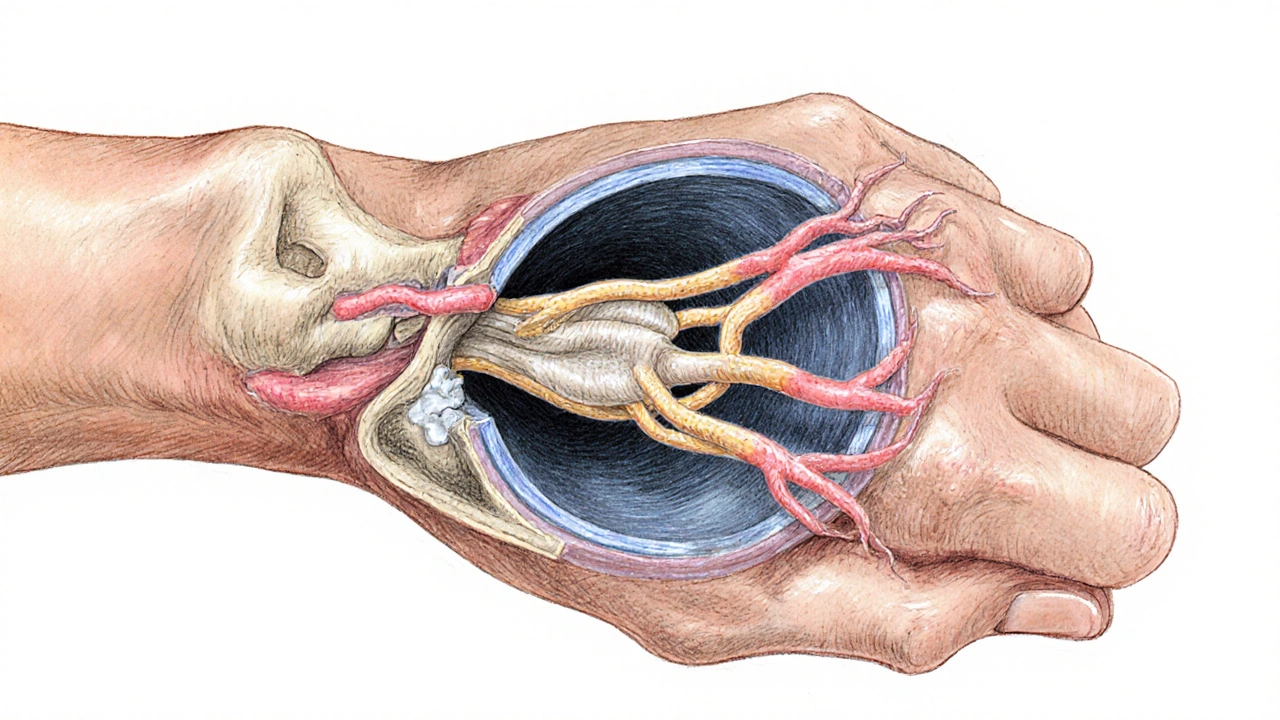Tendonitis & Carpal Tunnel Symptom Checker
Answer the following questions to assess your symptoms and determine if you may have overlapping issues with tendonitis and carpal tunnel syndrome.
Your Results
Did you know that up to 30% of office workers report wrist pain that stems from both tendonitis and carpal tunnel syndrome? Understanding how these two conditions interact can prevent months of missed work and endless doctor visits.
Quick Summary
- Both tendonitis and carpal tunnel syndrome affect the same wrist structures.
- Repetitive hand motions, poor ergonomics, and inflammation are common triggers.
- Symptoms often overlap, making diagnosis tricky.
- Early treatment-rest, splinting, and targeted therapy-helps avoid surgery.
- Long‑term prevention hinges on ergonomic adjustments and regular stretching.
Understanding tendonitis and its link to carpal tunnel syndrome can save you months of discomfort.
What Is Tendonitis?
Tendonitis is the inflammation of a tendon, the thick cord that connects muscle to bone. In the wrist, the most affected tendons are the extensor and flexor groups that control finger and thumb movement. When a tendon is overused, microscopic tears form, swelling occurs, and pain intensifies during motion.
What Is Carpal Tunnel Syndrome?
Carpal Tunnel Syndrome is a compression neuropathy that squeezes the median nerve as it travels through the carpal tunnel in the wrist. The tunnel is a narrow passageway formed by bone and a thick band of ligament. When the space narrows, tingling, numbness, and weakness spread from the hand up the forearm.
Key Anatomical Players
Two structures connect the two conditions:
- Median Nerve is the primary nerve that supplies sensation to the thumb, index, middle, and half of the ring finger.
- Wrist Extensor Tendons are the tendons that straighten the fingers and wrist, often irritated by repetitive typing.
How Tendonitis and Carpal Tunnel Syndrome Interact
Inflammation from tendonitis can cause swelling inside the carpal tunnel, directly increasing pressure on the median nerve. Conversely, prolonged nerve compression can alter muscle activation patterns, forcing certain tendons to work harder and become inflamed. This feedback loop explains why many patients experience both conditions simultaneously.

Common Risk Factors
Both ailments share several triggers that fall under the umbrella of Repetitive Strain Injury is injury caused by repeated motions or sustained awkward positions:
- Long hours of keyboard or mouse use without breaks.
- Improper wrist posture-bending upwards (extension) or downwards (flexion) for extended periods.
- Vibration exposure from power tools or handheld devices.
- Underlying conditions such as rheumatoid arthritis or diabetes that increase inflammation.
Addressing these factors early can halt the progression from mild irritation to chronic pain.
Diagnosis: Spotting the Overlap
Because symptoms often mirror each other-pain, tingling, reduced grip strength-clinicians use a combination of tests:
- Physical exam: Tinel’s sign (tapping over the median nerve) and Phalen’s maneuver (wrist flexion for 60 seconds).
- Ultrasound or MRI: Visualize tendon swelling and median nerve size.
- Electromyography (EMG): Measure nerve conduction velocity to confirm carpal tunnel compression.
When both imaging and nerve studies show abnormalities, a dual diagnosis is likely.
Treatment Options That Hit Both Conditions
Many therapies target inflammation and nerve compression simultaneously, offering a streamlined approach.
| Therapy | How It Helps Tendonitis | How It Helps Carpal Tunnel |
|---|---|---|
| Rest & Activity Modification | Reduces repetitive strain on inflamed tendons. | Lowers pressure inside the carpal tunnel. |
| Splinting (neutral wrist position) | Immobilizes the wrist, allowing tendon healing. | Keeps the median nerve from being pinched. |
| Physical Therapy | Improves tendon glide with eccentric exercises. | Strengthens forearm muscles that support the tunnel. |
| Corticosteroid Injections | Directly reduces tendon inflammation. | Decreases swelling around the median nerve. |
| Ultrasound Therapy | Promotes tissue healing through deep heat. | Can relieve nerve compression by breaking up adhesions. |
For stubborn cases, surgery may be required. Carpal Tunnel Release Surgery is a procedure that cuts the transverse carpal ligament to enlarge the tunnel. Tendonitis often improves after the nerve pressure is relieved, but surgeons may also address any tendon nodules encountered during the operation.
Prevention: Ergonomic Adjustments and Lifestyle Tweaks
Preventing the two conditions from feeding each other starts with a well‑designed workstation.
- Ergonomic Adjustments are changes to desk height, keyboard angle, and mouse design that keep the wrist neutral. A split keyboard or vertical mouse can cut extension stress by up to 40%.
- Take a 5‑minute micro‑break every hour to stretch the fingers, wrist, and forearm.
- Incorporate strength‑building exercises for the forearm flexors and extensors (e.g., wrist curls with light dumbbells).
- Stay hydrated and maintain a balanced diet rich in omega‑3 fatty acids, which can dampen systemic inflammation.
When to Seek Professional Help
If pain persists beyond two weeks despite rest, or if you notice numbness spreading to the thumb and index finger, schedule an appointment. Early referral to a hand specialist can prevent chronic nerve damage and avoid lengthy surgical recovery.
Next Steps and Troubleshooting
Below are actionable checkpoints you can run through at home. If any step fails, it’s a sign to get medical input.
- Apply ice to the wrist for 15 minutes, three times a day, for the first 48hours.
- Wear a neutral‑position splint at night for two weeks.
- Perform the "wrist flexor stretch" - gently pull the fingers back with the opposite hand, hold 20seconds, repeat five times.
- Begin a supervised physical therapy program focusing on eccentric tendon loading.
- If swelling or tingling worsens after a week of therapy, contact your physician for possible imaging.

Frequently Asked Questions
Can tendonitis cause carpal tunnel syndrome?
Yes. Swelling from tendonitis can reduce the space inside the carpal tunnel, increasing pressure on the median nerve and triggering carpal tunnel symptoms.
What are the first signs that both conditions are present?
A combination of dull, achy wrist pain that worsens with movement, plus intermittent tingling or numbness in the thumb, index, and middle fingers, often signals a dual issue.
Are over‑the‑counter anti‑inflammatories enough?
They can reduce mild inflammation, but they won’t address nerve compression. If symptoms linger beyond a week, seek professional evaluation.
Is surgery the only cure for carpal tunnel?
No. Many patients improve with splinting, ergonomic changes, and targeted therapy. Surgery is reserved for cases where non‑surgical measures fail after 3-6 months.
How long does recovery take after a tendonitis flare‑up?
Mild cases may resolve in 2-4 weeks with rest and therapy. More severe inflammation can take 8-12 weeks, especially if combined with nerve compression.

Great rundown! I especially liked the quick‑check table – it’s a handy way to see which therapies hit both issues at once. Rest and ergonomic tweaks are the real MVPs; they can stop the feedback loop before it spirals. If you’re already dealing with pain, ice for the first 48 hours and a neutral splint at night can make a huge difference. Keep the micro‑breaks coming and you’ll likely see improvement within a couple of weeks.
Honestly this article is just fluff Too many buzzwords and not enough real advice
You’ve nailed the interaction between tendon inflammation and median‑nerve compression. The explanation of how swelling narrows the carpal tunnel is spot‑on. I also appreciate the clear list of risk factors – they’re exactly what most desk workers overlook. The diagnostic section is thorough, especially the mention of EMG for confirming nerve involvement. For anyone juggling both issues, a combined treatment plan makes total sense. Keep educating readers; this kind of detail prevents years of unnecessary suffering.
Point taken – ergonomic changes aren’t optional, they’re essential. Ignoring them only deepens the problem.
The interplay you describe evokes a delicate balance, a biomechanical dance wherein each tendon’s strain whispers to the nerve. When inflammation crescendos, the tunnel contracts, and the median nerve feels the pressure. Such feedback loops merit deeper clinical scrutiny.
While the article is informative, certain sections could benefit from clearer structuring. The typographical errors, such as ‘flair’ instead of ‘flare’, slightly detract from its professionalism. Nonetheless, the core messages remain valuable. Consider a more formal abstract for academic readers.